| |
Sake's Hidden Stories
The Personalities, Philosophies, and Tricks-of-the-Trade Behind the Brew.
Go
beyond the basics of grades and production, and read stories about
actual brewers and what makes their sake what it is. This is what the
seminars and newsletters cannot teach you!
For a nice third-party review, see this cool blog.
Learn more and buy Sake's Hidden Stories HERE.
Another third-party cool blog review is here.
And yet a third cool blog review is here !
|
|
|
|
|
|
November Greetings To All Readers
Ah, November. It is always hard to believe the better part of yet 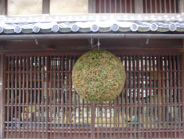 another year is gone... Just about now the many fall tastings begin to taper off and the industry looks inward to focus on brewing good sake for the next six months. Rumors indicate that some sake rice, like the inimitable Yamada Nishiki, are good this year, whereas others, such as the light-flavor producing Gohyakumangoku are not as good. But I am sure that we can count on the master brewers of the sake world to do their best. another year is gone... Just about now the many fall tastings begin to taper off and the industry looks inward to focus on brewing good sake for the next six months. Rumors indicate that some sake rice, like the inimitable Yamada Nishiki, are good this year, whereas others, such as the light-flavor producing Gohyakumangoku are not as good. But I am sure that we can count on the master brewers of the sake world to do their best.
This month, enjoy a story gleaned from a brewer during one fall tasting, read about sake events in Tokyo short and long, and learn a bit about rice harvest timing and its relationship to quality.
Enjoy the newsletter with some gently warmed o-kan, or perhaps your favorite holiday brew.
John |
It Just Gets Worse From Here On Out...
In the movie “Something About Mary,” Ben Stiller sat in the  backyard of his friend Dom whose wife doted upon them ridiculously. Beer, freshly baked cookies and more were brought in succession, and Ben’s character expressed how much he wanted something similar in his own life. Dom shrugged, glanced down complacently, and said, “Every day’s better than the next.” Lost on many a viewer, I am sure, the line was a harbinger of what was to come. backyard of his friend Dom whose wife doted upon them ridiculously. Beer, freshly baked cookies and more were brought in succession, and Ben’s character expressed how much he wanted something similar in his own life. Dom shrugged, glanced down complacently, and said, “Every day’s better than the next.” Lost on many a viewer, I am sure, the line was a harbinger of what was to come.
Every day is better than the next. Odd as the wording may be, there are actually some sake that are like that. Namely, contest sake made with massively milled rice and brewed using modern yeast strains.
I was at a ginjo tasting, one of many in the fall, and most of the 85 brewers there had a contest sake in their lineup for the day. One particular brewer, never at a loss for words (a fact that apparently bugs some of his more taciturn industry colleagues - but I digress) and I were chatting about his contest sake. It was the fall; the national contest for which it was brewed was held last May.
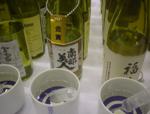 “It’s been in a deep freeze since then,” he began, “kept at -5C (23F) the whole time.” The contest is over, at least the one for which it was brewed, and they just have what remains hanging around for small sales, for tastings, and for the fall version of the spring contest… “It’s been in a deep freeze since then,” he began, “kept at -5C (23F) the whole time.” The contest is over, at least the one for which it was brewed, and they just have what remains hanging around for small sales, for tastings, and for the fall version of the spring contest…
…that spring contest being none other than the Zenkoku Shinshu Kampyoukai, or National New Sake Appraisal, at which this sake in question won a gold last year. There are various regional competitions around the country in the fall, using that specially brewed sake after it has been laid down for six months.
My brewer friend continued. “Sake like this, made with special contest yeasts and very highly milled rice will never get better than the moment it's born. After that it’s pretty much a long, slow demise.”
And why is this? Because those yeasts, as ostentatious and attention-getting as they are, do not provide the components of body and aroma that age well. “Sake like that Naraman over there,” he said, selecting one very good sake from amongst many in the brewer-manned booths along the far wall, “made with things like yeast Number Nine, that sake will taste better after a few months. But not this stuff.”
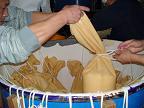 Again, it is a matter of its composition and its constitution. Contest sake is like daiginjo on steroids; intense, sharp, clean and focused in both flavors and aromas. (And good, mind you! This is not meant to be a detraction!) “Regular” sake has more components like amino acids, sugars, proteins and various acids that interact and meld, allowing richness, flavor, balance and well-roundedness to emerge over a few months. There is much less meat on the bones of contest sake, whereas normal sake has meaty stuff that you can grab onto and whack with a car antenna. And this leads to positive changes over a few months of maturation. Again, it is a matter of its composition and its constitution. Contest sake is like daiginjo on steroids; intense, sharp, clean and focused in both flavors and aromas. (And good, mind you! This is not meant to be a detraction!) “Regular” sake has more components like amino acids, sugars, proteins and various acids that interact and meld, allowing richness, flavor, balance and well-roundedness to emerge over a few months. There is much less meat on the bones of contest sake, whereas normal sake has meaty stuff that you can grab onto and whack with a car antenna. And this leads to positive changes over a few months of maturation.
As the brewer of that gold medal winner pronounced, “You press it, you pasteurize, you deep chill it. And from there, it basically deteriorates. After six months at that cold temperature, perhaps the corners will be a bit more well rounded, but we’ll not see much improvement in flavor or aromas, you see.”
Such delicate sake matures and changes quite fast. And, in fact, this is part of the skill of winning a contest. Not only does a brewer have to brew good sake, he or she needs to know just how it will be handled, and how it will change between the time it is submitted and the time it will be tasted. For example, they would need to know how a sake will change over two weeks at room temperature, after they have brewed it and kept it cold. Skill in this arena is important as well.
At the risk of sounding confusing, though, let us remember that almost all sake should be drunk young, and generally not aged (with a few exceptions, of course!). In other words, more aging is not better. But at the same time, most sake benefits from six months to a year of in-brewery maturation for the above-described reasons. It can lead to balance, depth, richness and more at first. But once they ship it to us, they want us to drink it fairly soon. So while contest sake starts to fade away right away, most sake matures gracefully for a short spell, then levels out before heading south for the long haul. six months to a year of in-brewery maturation for the above-described reasons. It can lead to balance, depth, richness and more at first. But once they ship it to us, they want us to drink it fairly soon. So while contest sake starts to fade away right away, most sake matures gracefully for a short spell, then levels out before heading south for the long haul.
With the ever-present exceptions that pepper every part of the sake  world notwithstanding, most sake needs a short period of maturation, after which it should not be aged. That is the short version of the story. world notwithstanding, most sake needs a short period of maturation, after which it should not be aged. That is the short version of the story.
But contest sake is different. For such sake, every day is indeed better than the next.
|
Did you know? Rice Harvest Timing...
"Yamada Nishiki vs. Gohyakumangoku"
Of the approximately 100 varieties of sake rice currently in use, there  are those that are harvested early in the fall, September or so, and those that are harvested later, like the end of October. This depends on the strain, the locale, the weather and more. Generally speaking the better varieties are harvested later. But that is an arguable call. are those that are harvested early in the fall, September or so, and those that are harvested later, like the end of October. This depends on the strain, the locale, the weather and more. Generally speaking the better varieties are harvested later. But that is an arguable call.
How was this year's crop? Well, that depends...
Those varieties that are harvested early in the season, such as Gohyakumangoku which grows on the western shores and a bit to the north, are mediocre. Why? Because there was lots of rain and not enough sun near the end of the summer.
Conversely, varieties that are harvested later, like the mighty Yamada Nishiki, ended up quite fine since the early autumn warmed up and got sunny, giving that rice just it wanted for a few solid weeks. So we have much to look forward to this year as well.
And, as is always the case with sake, there will be exceptions and vagary. The above is an approximation based on hearsay. A good toji (master brewer) can work his or her magic with any given rice and make superb sake. So let us wait and see, with great expectations.
|
Sake Brewery Tours: we are live NOW!
Sake Tourism has begun!
Want to visit sake breweries in Japan? Now you can!

I am
pleased to announce the starting of the Sake World Sake Brewery Tours
program. Now, anyone can access the inner workings of the sake world.
Visit Japan, start off with a bit of formal sake education by yours
truly, then you are off to see several sake breweries while under the
care of an experienced sake-savvy interpreter. Events include
sake-centered meals and other cultural sight-seeing options - and even
a bit of free time. This brewing season, there are two tours planned:
Tour I: February 23 to 27 in the Kansai (Osaka/Kyoto/Kobe) area
Tour II: March 15
to 19 in the San-in (Shimane and Tottori) area
For more information,
pricing and reservations please go to www.saketours.com. Participation
is extremely limited this season for the two tours that are scheduled. |
|
Sake and Pottery Seminar November 21
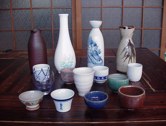 On the evening of Saturday, November 21, from 6pm to 9pm, Rob Yellin and I will host the first Sake and Pottery Seminar of the year (!) at Takara in Yurakucho. The sake topic will be "The Leverage of the Post -Brewing Steps," or how big an effect the comparatively simple-sounding steps of pasteurization, filtration, bottling and adding water can have. The pottery topic will be "Bizen Pottery." On the evening of Saturday, November 21, from 6pm to 9pm, Rob Yellin and I will host the first Sake and Pottery Seminar of the year (!) at Takara in Yurakucho. The sake topic will be "The Leverage of the Post -Brewing Steps," or how big an effect the comparatively simple-sounding steps of pasteurization, filtration, bottling and adding water can have. The pottery topic will be "Bizen Pottery."
The evening will begin at 6:00 and end about 9:00 pm. The cost for the seminar, materials, six sake and dinner is 7000 yen. Those interested in attending can make a reservation by sending me an email at sakeguy@gol.com. Any questions about the seminar? By all means, feel free to ask.
It is the first seminar of the year, but is likely to be the last as well since Rob and I both get busy near year-end. Don't miss it! Make a reservation today with an email to sakeguy@gol.com. (Note you may need to deal with a spam blocker: your patience and persistence are appreciated.)
Hope to see you there,
John Gauntner and Rob Yellin
The 2010 Sake Professional Course
...in Japan
January 25 to 29, 2009
The 2010 Sake Professional Course will take place in Tokyo (and Osaka, Kyoto and Kobe) Japan from Monday January 25 to Friday January 29, 2010.This is it, folks: simply the most thorough sake education on the planet. Three days of instruction and tasting are augmented by two days of sake brewery visits, with evenings filled with good food and the best sake Japan has to offer. Reservations are being taken now, and are expected to go fast. For more information please go here, and/or to reserve, please email me at sakeguy@gol.com.
|

Are you not getting this newsletter? I realize that is likeasking that "those not present please raise your hand," but for future reference, should you spontaneously stop receiving this newsletter, please go here and sign up again. Should that not work, please go to www.sake-world.com.
Email newsletter services are very careful not to be considered spam enablers, but the problem is that often very valid email addresses come back bounced as invalid. It is an unavoidable problem. So if you or someone you know is not getting this, or stop(s) receiving it inexplicably, please do take a moment to double check that you are still subscribed.
Sincere apologies for the hassle, mixed with gratitude for reading this newsletter.
|
Sake's Hidden Stories
I am very pleased, if not relieved, to finally announce the publication of my new ebook, Sake's Hidden Stories, subtitled The Personalities, Philosophies, and Tricks-of-the-Trade Behind the Brew.
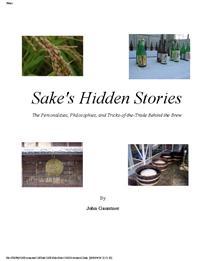 Sake's Hidden Stories ($14.99) will give you a view to what goes on in the sake industry behind the brew we all love so much. The book goes into stories much deeper than the information we most commonly encounter; way beyond simply what ginjo-shu is, what junmai-shu is, or what the role of koji is. You will learn about the personalities behind the sake. You will see in just how much detail some brewers make sake, and how each is different in where importance is placed. And most significantly, something that has not been written about in any book on sake in English, you will meet more than a dozen brewers, and encounter their personalities. You'll see what makes them tick, what drives them in their work, and how their histories and idiosyncrasies affect the sake they brew.
Sake's Hidden Stories ($14.99) will give you a view to what goes on in the sake industry behind the brew we all love so much. The book goes into stories much deeper than the information we most commonly encounter; way beyond simply what ginjo-shu is, what junmai-shu is, or what the role of koji is. You will learn about the personalities behind the sake. You will see in just how much detail some brewers make sake, and how each is different in where importance is placed. And most significantly, something that has not been written about in any book on sake in English, you will meet more than a dozen brewers, and encounter their personalities. You'll see what makes them tick, what drives them in their work, and how their histories and idiosyncrasies affect the sake they brew.
For more information on content and get your copy, go here.As with any ebook or informational product I offer, satisfaction is 100% guaranteed. If you don't like it or feel it was worth what you paid for it, I will cheerfully refund your money.
Finally, for a nice third-party review of the book, check out this cool blog.
Sake Educational Products
Jump-start your sake savvy
ust a reminder to check out the Sake-World e-store,currently offering 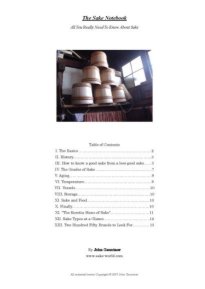 three educational products immediately downloadable for your education and further sake enjoyment. See Educational Products at Sake-world.com.
Currently, we have three products, with more to come soon, including a
full-blown, comprehensive self-study course covering all the material
in the Sake Professional Course, and more. three educational products immediately downloadable for your education and further sake enjoyment. See Educational Products at Sake-world.com.
Currently, we have three products, with more to come soon, including a
full-blown, comprehensive self-study course covering all the material
in the Sake Professional Course, and more.
First is The Sake
Notebook, a 15-page pdf file guaranteed to jump-start your sake
understanding and appreciation. It covers everything related to sake in
a tight, concise and easily digestible presentation replete with plenty
of photos and diagrams for at-a-glance enlightenment. Sake basics,
history, grades and quality levels, aging, temperature, storage and
more are all briefly touched upon to create a foundation upon which
more sake learning can flourish. There is also a list of 250 (count
'em!) sake brands to look for and try. Finally, included with purchase
is access to a password protected area on www.sake-world.com known as
"The Goodstuff" a regularly updated list of good sake recommendations,
replete with brief commentary on each, and some indication of John's
personal recommendations and preferences. Available for $15.
Next
is The Sake Production Slideshow, an executable file (Photojam) wherein
resides a 15-minute slideshow of photos of the sake-brewing process
from beginning to end, giving you a glimpse into the day-to-day brewing
environment of sakagura in Japan. Available for $15. Also, access to
"The Goodstuff" comes with this product as well.
Third is a
bundled package of both The Sake Notebook and The Sake Production
Slideshow for those that cannot make up their minds or simply have to
have - or give - both as gifts. Available as a set for $25.
Surely
these would make wonderful gifts for those close to you that are
itching to get into good sake, and their easily downloadable digital
format makes it all that much easier. |
Odds-n-Ends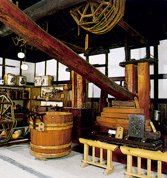 Links to Sake Book Info and Archives
Links to Sake Book Info and Archives
Past Issues Posted
The archives of this newsletter are again up-to-date. If you have missed any, feel free to check them out on the Sake-World site.
More information on the following topics can be found at
www.sake-world.com/html/nl_related.html
Sake Homebrewing
Books on Sake
Information on the archives of this newsletter
General information related to this publication |
I hope you have found the above information helpful
and 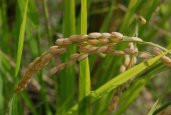 entertaining. For more information about all things sake, please
check out www.sake-world.com. Until next month, warm regards, and enjoy
your sake. entertaining. For more information about all things sake, please
check out www.sake-world.com. Until next month, warm regards, and enjoy
your sake.
Questions and comments should be directed to John Gauntner, at the email address above.
All material Copyright, John Gauntner & Sake World Inc.
Regards,
John Gauntner
Sake World, Inc. |
|
